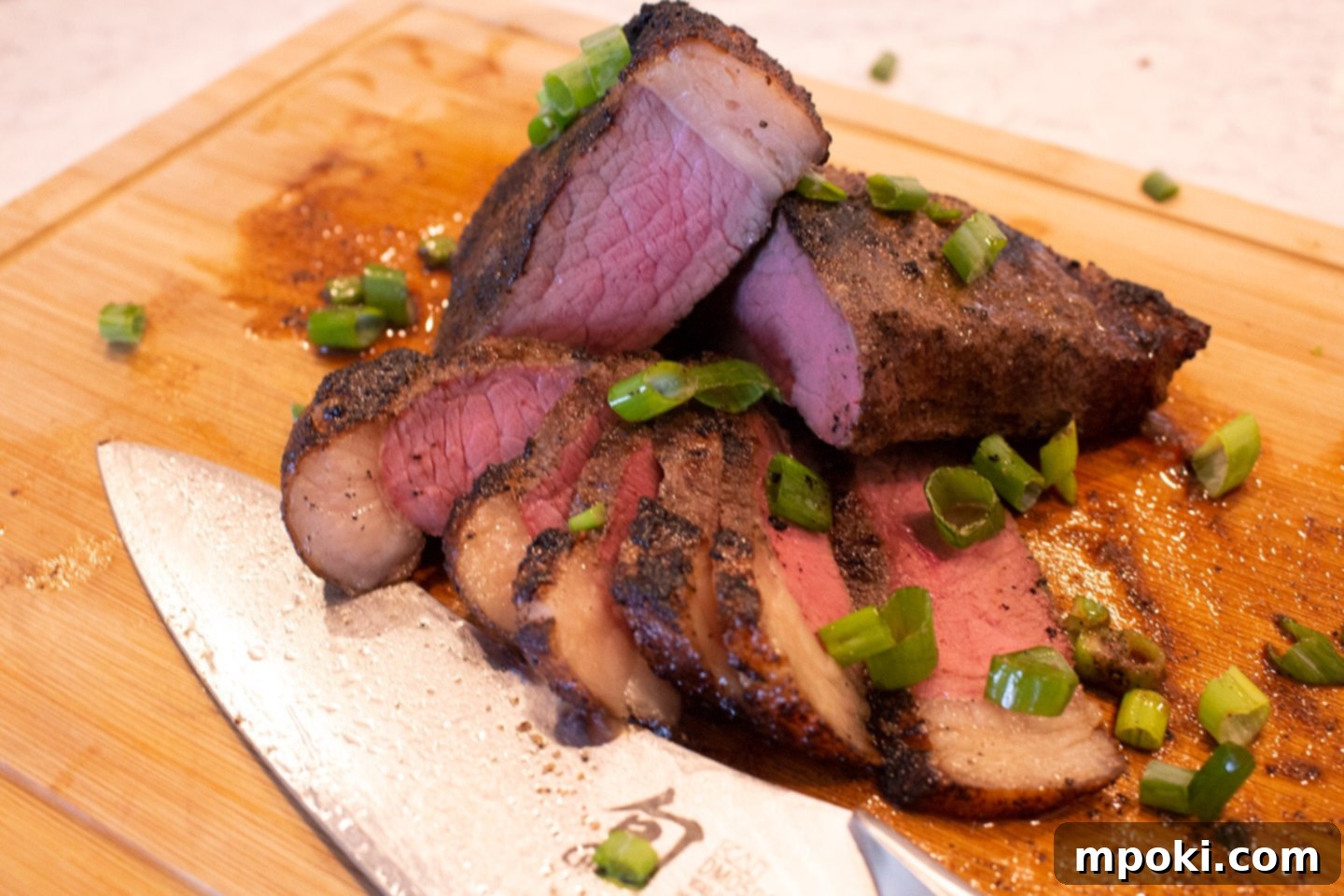Embark on a culinary journey to transform an exceptional cut of beef into an unforgettable dining experience with this guide to Sous Vide Picanha. This recipe is designed for both novice home cooks and seasoned grill masters, leveraging the precision of sous vide to guarantee perfect edge-to-edge medium-rare doneness every single time. Paired with the intense flavor of a charcoal sear, you’ll create a steak that rivals the finest Brazilian steakhouses.
The secret lies in the sous vide technique, which eliminates guesswork and delivers consistent results. What once seemed like a professional chef’s exclusive tool, immersion circulators have become remarkably accessible and affordable. As many experienced home cooks attest, steak is the ideal starting point for anyone new to sous vide, as it beautifully showcases the method’s unparalleled benefits compared to traditional cooking, which often involves a delicate balance of timing and intuition.
PIN IT TO PINTEREST
Save this incredible recipe to Pinterest and share the joy of perfectly cooked picanha.
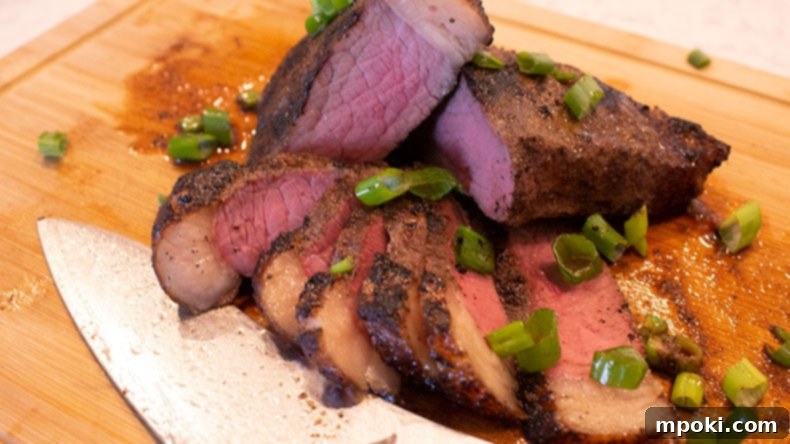
This page contains affiliate links. For more information, please see our disclosures here.
The Ultimate Guide to Sous Vide Picanha: From Prep to Perfect Sear
Picanha, often referred to as Sirloin Cap, is a prized cut of beef celebrated for its rich flavor and tender texture, especially when prepared correctly. This guide will walk you through every step of cooking picanha using the sous vide method, culminating in a spectacular charcoal-seared finish. Get ready to impress your family and friends with a steak that’s consistently juicy, tender, and bursting with flavor.
Preparing Your Picanha: Precision Cutting for Optimal Tenderness

The journey to a perfect picanha steak begins with the proper cut. You’ll want to slice your picanha into generous 1.5 to 2-inch thick steaks. This thickness is crucial for sous vide cooking, as it provides enough mass to allow for a robust sear on the exterior without overcooking the perfectly tender interior you’ve achieved through the water bath.
A key step often overlooked by many is to cut the picanha with the grain. While this might seem counterintuitive for tenderness, it ensures that when the steak is finally served and cut by the diner, their final slices will be made across the grain. This technique shortens the muscle fibers, resulting in an incredibly tender bite. Take your time with this step; it makes a significant difference in the final eating experience.
Seasoning Your Picanha: Building Layers of Flavor
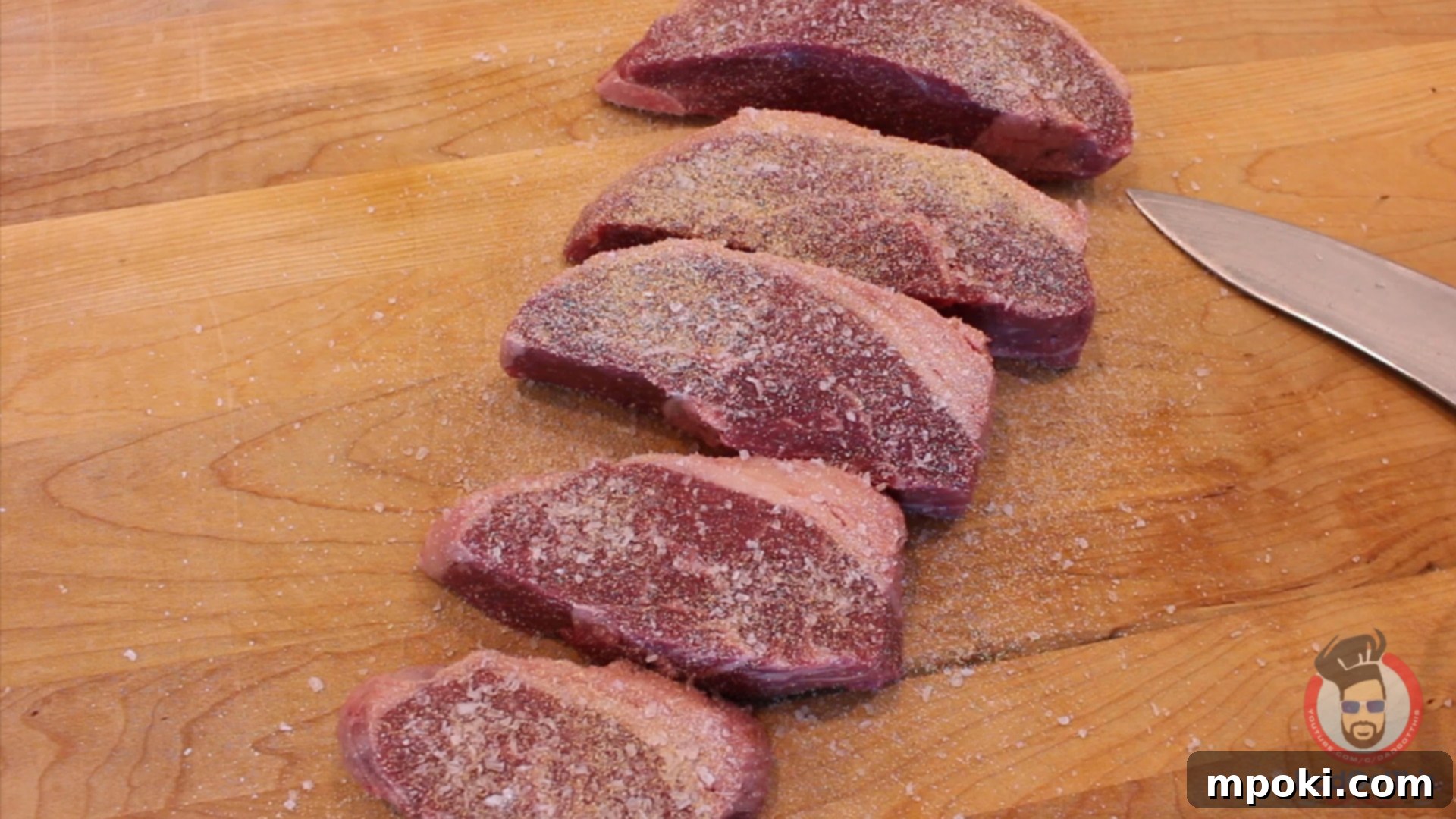
Picanha, with its distinct beefy flavor, can handle a substantial amount of seasoning. Don’t be shy here! Liberally coat your steaks with a combination of coarse salt, garlic powder, and onion powder. A simple 50/50 mix of garlic and onion powder works wonderfully, allowing the natural flavor of the beef to shine while adding savory depth.
It’s important to remember that during the sous vide process, a small amount of seasoning may wash off into the bag, and more will be lost during the high-heat searing stage. Therefore, applying a heavier hand with your spices than you might typically for a conventional steak is recommended. When in doubt, err on the side of more seasoning to ensure a flavorful crust after searing.
Sealing for Sous Vide: Vacuum Pack or Water Displacement

Once seasoned, your picanha steaks are ready for sealing. Place one to two steaks per vacuum bag, ensuring they lie flat and are not overcrowded. A vacuum sealer is the most efficient way to remove air, creating a tight seal that prevents water from entering the bag and maximizes heat transfer.
However, if you don’t own a vacuum sealer, don’t worry! You can easily achieve a similar result using the water displacement method with a freezer-safe Ziploc bag. Simply place your seasoned steak in the bag, slowly submerge the bag into a large pot of water (leaving the top unsealed), and let the water pressure force the air out around the food. Once most of the air is removed, carefully seal the bag while it’s still partially submerged. This technique works perfectly and ensures your steak cooks evenly. For a visual guide, you can refer to our sous vide ribeye recipe and video, where this method is demonstrated.
Setting Up Your Sous Vide Water Bath: Precision Temperature Control

Now it’s time to set up your immersion circulator. Follow the manufacturer’s instructions for your specific device. Many popular models, like the Anova Precision Cooker, conveniently clip to the side of almost any heat-safe container. Choose a container large enough to comfortably hold all your sealed picanha bags, allowing ample space for water circulation around each steak. Proper circulation is key to maintaining a consistent temperature throughout the bath.
Fill your container with water and set your immersion circulator to the desired temperature. For a perfect medium-rare picanha, we recommend a temperature of 134 degrees Fahrenheit (56.7 degrees Celsius). If you prefer a medium doneness, set it to 140 degrees Fahrenheit (60 degrees Celsius). For those who prefer well-done (though we strongly encourage you to try medium-rare!), a setting of 160 degrees Fahrenheit (71.1 degrees Celsius) would be appropriate.
Once the water bath reaches the target temperature, carefully submerge your vacuum-sealed bags of picanha. Ensure they are fully immersed and not floating; you might need to use a heavy object or a lid to keep them submerged. Cook the picanha sous vide at 134 degrees Fahrenheit for 1.5 hours. This duration allows the thick steaks to reach their ideal internal temperature, becoming incredibly tender without any risk of overcooking.
The Critical Step: Drying Your Steaks Thoroughly
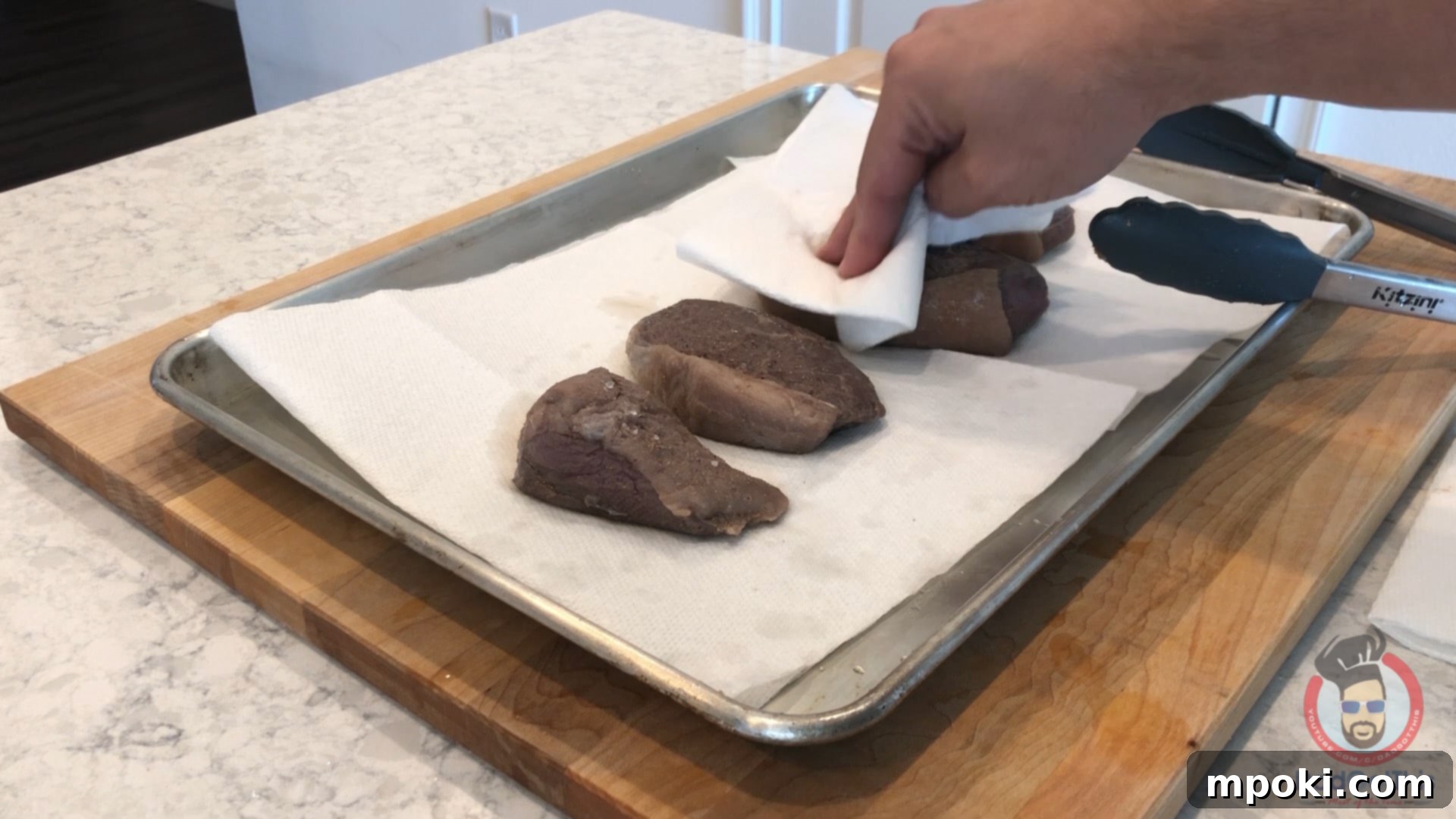
After the sous vide cooking time is complete, carefully remove the bags from the water bath. This next step is incredibly important for achieving that perfect, crispy crust: thoroughly pat your steaks dry. Use paper towels to remove all surface moisture from every side of the steak.
This step cannot be emphasized enough. If there is any moisture remaining on the exterior of the steak, the heat from your searing method will first expend energy evaporating that water before it can begin to brown and form a crust. This leads to a steamed rather than seared surface, preventing the Maillard reaction that creates those delectable flavors and textures. Once your steaks are meticulously dry, they are perfectly primed for searing.
Mastering the Sear: Unleashing Flavor with a Charcoal Grill
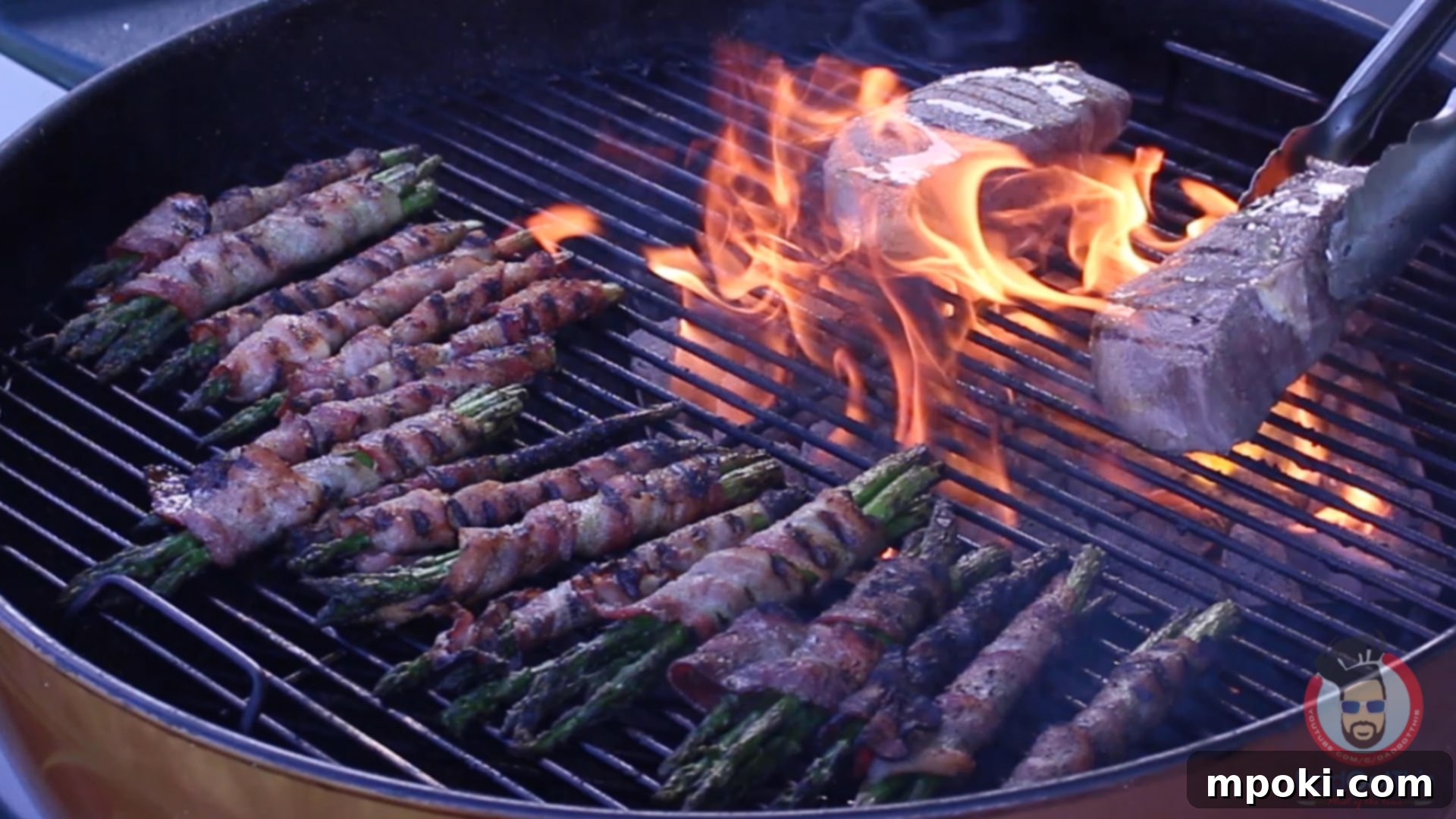
While there are many excellent ways to sear a sous vide steak, using a charcoal grill is one of our absolute favorites, especially when time allows. The smoky flavor imparted by charcoal is simply unparalleled. The key to a successful charcoal sear is to ensure your grill is set up to burn as hot as possible. Create a super-hot zone directly over the coals.
Place your dried picanha steaks directly over the high heat and begin flipping them frequently. The goal is to develop a beautiful, deep brown crust on all sides. Be mindful of the time – the internal temperature of the steak is already perfect, so you are only aiming for color and texture on the exterior. Do NOT prolong this searing process, or you risk overcooking the interior you worked so hard to perfect.
Aim for a total searing time of no more than 2-3 minutes per steak; in this scenario, shorter is always better. A clever trick to enhance the crust and char is to intentionally induce a flare-up. By drizzling a tiny amount of vegetable oil directly onto the steaks while they are on the hot grill, you can create a controlled flare-up that adds incredible char and flavor in seconds. This quick, intense heat is what makes charcoal searing so effective for sous vide steaks.
SOUS VIDE PICANHA – CHARCOAL SEARED
Print
Pin
Rate
Equipment
- Immersion Circulator
- Charcoal Grill
Ingredients
- 1 Picanha 3-4 Pounds
- 1 GO (Garlic Powder/Onion Powder) In a Shaker 50/50 Mix Ratio
- 5 tablespoon Olive Oil Just enough to drizzle when grilling
- 4 tablespoon Coarse Salt This is an estimate. You can go as heavy or light as you like on the salt. Sous vide Picanha can take a lot of seasoning.
Instructions
- Cut your whole picanha roast into 1.5 to 2-inch thick steaks. Remember to cut with the grain for optimal tenderness when served (refer to our video for a visual demonstration if needed).
- Season the picanha steaks liberally on all sides with a generous amount of coarse salt, garlic powder, and onion powder. Don’t be afraid to apply a thick coating.
- Place 1-2 seasoned steaks into individual vacuum-sealable bags. If you don’t have a vacuum sealer, use freezer-safe Ziploc bags and employ the water displacement method to remove as much air as possible before sealing.
- Set up your immersion circulator in a suitable water bath container and heat the water to 134 degrees Fahrenheit (56.7 degrees Celsius) for a perfect medium-rare result. Adjust temperature for desired doneness if preferred.
- Once the water reaches the target temperature, carefully submerge your sealed bags of picanha into the water bath, ensuring they are fully submerged.
- Cook the picanha steaks “Sous Vide” at 134 degrees Fahrenheit for 1.5 hours.
- After 1.5 hours, remove the sealed bags from the water bath.
- Carefully remove the steaks from their bags and pat them thoroughly dry on all sides using paper towels. This step is critical for a good sear.
- Sear the dried steaks over an extremely hot charcoal grill. Flip them frequently to develop an even, deep brown crust. This searing process should be very quick, ideally 2-3 minutes max, as the steak is already cooked. You are only aiming for color, flavor, and texture on the exterior. Be careful not to overcook the interior.
- Optional: Drizzle a little vegetable oil on the steaks while searing to create controlled flare-ups and enhance the crust.
- Remove from heat, allow to rest for a few minutes, then slice against the grain and serve immediately. Enjoy your perfectly tender and flavorful Sous Vide Picanha!
Video
Notes
Desired Doneness Temperatures:
Medium Rare: 134 Degrees F (56.7 C)
Medium: 140 Degrees F (60 C)
Well Done: 160 Degrees F (71.1 C)
Pro Tip for Pan Searing/Oven Broiling: If you plan to finish your picanha using a pan sear or oven broiler, consider setting your immersion circulator to a slightly lower temperature, such as 131 degrees F (55 C). This accounts for the slightly longer searing time these methods might require compared to a super-hot charcoal grill, helping to prevent the internal temperature from rising beyond your desired medium-rare.
Nutrition
 Tried this recipe?Mention @DadGotThis or tag #DadGotThis!
Tried this recipe?Mention @DadGotThis or tag #DadGotThis!Deep Dive: Understanding Sous Vide & Picanha
What Exactly is Sous Vide? A Chef’s Secret for Home Cooks
For those unfamiliar with the sous vide technique, let’s break it down. “Sous Vide” is French for “under vacuum,” which perfectly describes the method: food is sealed in a bag, typically with all air removed, and then submerged in a precisely temperature-controlled water bath. This method has revolutionized how professional kitchens prepare food, ensuring consistent quality and perfect doneness, and now it’s readily available for home use.
Unlike traditional cooking methods where temperatures can fluctuate wildly, leading to unevenly cooked food, sous vide maintains an exact temperature throughout the cooking process. This means your food cooks gently and uniformly from edge to edge, achieving perfect results every time.
How an Immersion Circulator Works and Its Benefits
The “sous vide machine” many refer to is actually an immersion circulator. This clever appliance clips to the side of a pot or container, heats the water to a precise temperature, and then constantly circulates it. Think of it as a personal, high-tech hot tub for your food!
The core benefit is simple yet profound: by cooking food at the exact temperature you desire for its final doneness, it is impossible to overcook it. If you set your circulator to 134 degrees Fahrenheit for medium-rare, your steak will never exceed that temperature, no matter how long it stays in the bath (within reasonable limits, of course). This eliminates the stress of timing and creates culinary masterpieces with ease.
Another fantastic advantage is moisture retention. Since the food is sealed in a bag, all its natural juices and flavors are locked in, resulting in incredibly moist and flavorful outcomes that often surpass traditional cooking methods. No more dry, overcooked meat! If you’re keen to explore the fundamentals further, our comprehensive post and video on the basics of sous vide offer a deeper dive into this fascinating cooking style.
Picanha Unveiled: The Star of Brazilian Steakhouses
In many parts of the world, particularly in Brazil, picanha is a highly celebrated cut of beef. In North America, you might find it labeled as Sirloin Cap, Coulotte, or Rump Cap. While it might not always be prominently displayed at your local grocery store, don’t hesitate to ask your butcher for it. This cut is a fantastic value, often more affordable than premium steaks like a New York Strip, yet delivering exceptional flavor.
Picanha is characterized by a thick layer of fat on one side, known as the “fat cap.” This cap renders down during cooking, basting the meat and imparting incredible flavor and moisture. The meat itself comes from the top of the rump, just above the hip, and is distinct from other cuts often derived from this region. Unfortunately, in many American butcher shops, this glorious cut is often broken down into smaller, less exciting cuts like round, rump, or loin, making a whole picanha roast a bit of a hidden gem.
Why Picanha and Sous Vide Are a Match Made in Culinary Heaven
Picanha’s unique characteristics make it an ideal candidate for sous vide cooking. The lean meat, paired with its distinctive fat cap, can easily become dry and tough if not cooked with extreme precision. This is where sous vide truly shines. The controlled, low-temperature cooking environment gently tenderizes the meat while rendering the fat cap beautifully, ensuring the steak emerges from the water bath incredibly tender, juicy, and infused with rich, beefy flavor.
The final step of searing the steak on a charcoal grill adds a layer of authentic, smoky char that perfectly complements the sous vide tenderness. This combination delivers a steak with a flawless interior and a deliciously crisp exterior, elevating the picanha to steakhouse quality right in your backyard.
If a charcoal grill isn’t an option, you still have several excellent alternatives for searing. A hot gas grill can achieve a great crust, as can a screaming-hot cast-iron skillet (pan sear) on your stovetop. You can even use the broiler in your oven for a quick finish. However, for maximum flavor and that perfect smoky char, a charcoal grill remains the top choice for many, including us.
Remember, if you opt for pan searing or using your oven’s broiler, consider setting your sous vide temperature slightly lower, around 131 degrees Fahrenheit (55 degrees Celsius). This minor adjustment helps to account for the slightly longer searing time these methods might entail, ensuring your medium-rare perfection isn’t compromised by residual cooking during the final step.
Don’t Miss Out on More Delicious Recipes!
For more fantastic cooking tips, delicious recipes, and engaging videos, make sure to visit our YouTube channel! Subscribe and join our community of home cooks passionate about great food.
Craving More Sous Vide Excellence? Try Our Tender Sous Vide Ribs!
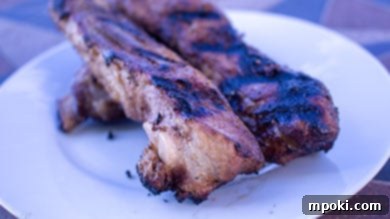
If you’ve enjoyed the precision and tenderness of sous vide picanha, you’ll love our recipe for Sous Vide Ribs. These ribs are consistently tender, incredibly moist, and surprisingly easy to prepare. Whether you cook them for 12 or 24 hours, they turn out absolutely delicious, falling off the bone with rich flavor. It’s another perfect example of how sous vide elevates classic dishes.
Click here to discover the secret to perfect Sous Vide Spare Ribs.
